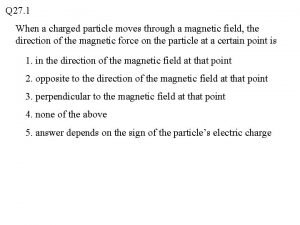Charged particle transverse momentum spectra measured at midrapidity

- Slides: 1

Charged particle transverse momentum spectra measured at mid-rapidity by STAR in the RHIC Beam Energy Scan Stephen Horvat (for the STAR Collaboration) Abstract Motivation Spectra Method 0 -5% π+ • Proving that the QGP is formed at top RHIC and LHC energies requires that p K+ signatures for its existence vanish as collision energies are reduced • Colliding energies were varied from 200 Ge. V down to 7. 7 Ge. V in the RHIC beam energy scan, and this range may be extended to even lower energies with the fixed target program proposed by STAR Preliminary Statistical errors only • Cold nuclear matter effects were shown to compete with the mechanisms leading to suppression through d + Au collisions K+ π+ • Models employing different physical mechanisms can be tested against the data p STAR Preliminary in an effort to model the relative contributions from these competing effects • Two models are shown here; HIJING and AMPT • HIJING is a QCD-based Monte Carlo event generator 60 -80% • AMPT is similar, but adds transport to the partonic and hadronic phases Au + Au Central Phys. Lett. B 637 (2006) 161 d. Au 200 Au. Au 200 Protons STAR Preliminary Statistical errors only p. T (Ge. V/c) • Kaons and pions show a stronger energy dependence than protons RCP • Less energy dependence for central than for peripheral collisions Au + Au Peripheral Pions • The inclusive measurement has a higher p. T reach, while the identified measurement enables the study of species dependence in RCP, as well as NBin ≡ number of binary collisions (from a Glauber MC model) Phys. Rev. Lett. 91 (2003) 172302 Ann. Rev. of Nucl. and Part. Sci. 57, 205 (2007) RCP HIJING 1. 383 particle ratios and related measurements AMPT 1. 21 K+ STAR Preliminary p. T (Ge. V/c) • AMPT uses HIJING to generate its initial conditions • It adds Zhang's Parton Cascade for describing partonic scatterings and A Relativistic Transport model for hadronic scatterings • Although Lund fragmentation is used for hadronization in both HIJING and AMPT, AMPT’s Lund parameters were further tuned to NA 49 data • Additional details can be found in Zi-Wei Lin et al. 2005 Phys. Rev. C 72 064901 • The default version of AMPT fails to reproduce the energy dependence of RCP but does qualitatively capture the species dependence • AMPT does not reproduce the spectra from data Phys. Rev. Lett. 91 (2003) 172302 Nucl. Part. Phys. 38 (2011) 124080 RCP AMPT __________ RCP Data RCP HIJING ___________ RCP Data ratio of charged particle spectra from HIJING to that from data in 60 -80% centrality ratio of charged particle spectra from HIJING to that from data in 0 -5% centrality ratio of charged particle spectra from AMPT to that from data in 60 -80% centrality Gyulassy M. and Wang X. 1994 Comput. Phys. Commun. 83 307 Conclusions Zhang B. et al. 2000 Phys. Rev. C 61 067901 ratio of charged particle spectra from AMPT to that from data in 0 -5% centrality

